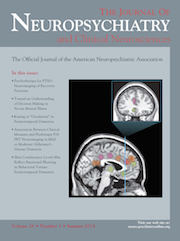Othello Syndrome After Cerebrovascular Infarction
To the Editor: Although several psychiatric symptoms can occur after a stroke, hallucinations and delusions seem to be uncommon.1 Othello syndrome, or delusional jealousy, was mainly reported in schizophrenia, dementia, and alcoholism.2 We present two cases of delusional jealously after acute right middle cerebral artery ischemic stroke.
Case Report
Case #1
A 65-year-old man presented at our hospital with sudden onset left hemianopia and left mild hemiparesis. MRI showed right temporoparietoinsular ischemic lesion (Figure 1). Etiological investigation identified an occluded right internal carotid. One week later, he started accusing his wife of having a sexual relationship with one of their sons, insisting on a paternity test of their youngest daughter, as he was certain that she was the result of an incestuous relationship. He also believed that he was in danger of being murdered by his wife for knowing of this imagined relationship. He was treated with fluvoxamine and chlorpromazine, with symptomatic relief over the following weeks. At 6-month follow-up, he still had nondisruptive residual delusional activity.

Case #2
A 69-year-old man presented at our hospital for sudden-onset euphoria, left hemianopia, and very mild left hemiparesis. The patient had an outstanding elation, laughed inappropriately, continuously shouted that he trusted in Medicine, called the doctor whom he had never seen before the “King of Medicine,” and over complied with neurological exploration, clownishly waving his arms and legs. MRI showed a temporoparietoinsular right ischemic lesion (Figure 2). Etiological investigation identified an occlusion of the right internal carotid. On the second day, he started being jealous of his wife, thinking that she was involved with other patients on his ward. Over the following weeks, he started accusing her of being sexually involved with his oldest son (of a previous marriage). He was treated with sertraline and quetiapine, with complete resolution of the delusional activity over the next 4 months.

Discussion
The incidence of psychotic symptoms after stroke ranges from 1% to 5.3%.1 The majority of cases occur after right hemispheric lesion, mainly in the temporoparietal posterior region.1 Psychotic symptoms can arise immediately to years later, and last for a variable period.1 There is no specific location for jealousy delusions, with frontal, posterior parietal, striatal, and thalamic lesions being implicated.1 It was suggested that psychosis after right hemispheric stroke could result from left hemispheric hyperactivity.3
Post-stroke mania has been similarly linked to right hemisphere damage causing right corticolimbic disruption and left positive diaschisis.4 Our second patient provides practical evidence for this continuum, pointing for a common anatomical underlying dysfunction on both secondary mania and psychosis.
It should be noted that, despite this clinicoradiological correlations, we cannot overlook the contributory role of psychological factors, such as previous jealousy or paranoid personality traces.5
Our almost identical patients are examples of or delusional jealousy arising from acute vascular damage. They share right temporoparietal lesions and seem to have a reasonable response to antipsychotics and selective serotonin reuptake inhibitors.
Future investigations should explore psychological, cognitive, and anatomical changes observed during the emergence and resolution of delusions, as well as strategies to treat them, perhaps targeting left hemisphere hyperactivity.
1 : Delusional state following acute stroke. Neurology 2004; 62:110–113Crossref, Medline, Google Scholar
2 : Quetiapine for hypersexuality and delusional jealousy after stroke. J Clin Psychopharmacol 2006; 26:331–332Crossref, Medline, Google Scholar
3 : Delusional misidentifications and duplications: right brain lesions, left brain delusions. Neurology 2009; 72:80–87Crossref, Medline, Google Scholar
4 : Diagnostic and Statistical Manual of Mental Disorders, Fourth Edition. Symptoms of mania: which one(s) result(s) more often from right than left hemisphere lesions? Comp Psychiatry 2008; 49:441–459.Crossref, Medline, Google Scholar
5 : Neuroimaging correlates of chronic delusional jealousy after right cerebral infarction. J Neuropsychiatry Clin Neurosci 2008; 20:245–247Link, Google Scholar



